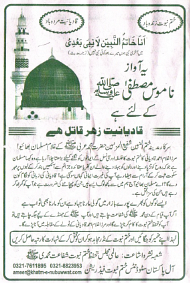Editorials |
.
Setting their house in order
Setting their house in order
Hindustan Times
June 15, 2010
First Published: 22:03 IST(15/6/2010)
Last Updated: 22:06 IST(15/6/2010)
June 15, 2010
First Published: 22:03 IST(15/6/2010)
Last Updated: 22:06 IST(15/6/2010)
When the topic of terrorism-related threats is discussed, most of us think of Pakistan, Afghanistan, the Taliban and al-Qaeda. The scene of activity is the Federally Administered Tribal Areas (Fata) and the borderlands of Afghanistan and Pakistan. There are visions of Predators stalking the region to search and kill. When this is not the scene, then it is the threat to the US from the likes of Times Square wannabe-bomber Faisal Shahzad, their mindsets and their mentors.
When an angered and frightened US speaks of retaliation to this, it speaks of the wrath of America the next time around. Pakistan’s rulers pretend anger and insult, and they let loose their leg men on the streets shouting ‘Death to America!’. The Americans are in a dilemma. They cannot attack their favourite ally and justify to Congress that they need to give more arms and financial assistance to it. Pakistan’s rulers feel they have a winning game — of threatening to lose the match and country if they are not given steroids. Pakistan’s battle is not only on its western frontiers; it is now in the Punjabi heartland.
Since the Lal Masjid episode in Islamabad in 2007, the murderous terrorist attacks on the Marriot Hotel, the General Headquarters in Rawalpindi, Inter-Services Intelligence (ISI) and Special Service Group establishments as well as the police show the reach of the terrorists. The twin attacks on the Garhi Shahu and Model Town Ahmadiya masjids in Lahore on Friday, May 28, the attack on Jinnah Hospital on the night of May 31 and the June 9 attack on the Nato convoy outside Islamabad are manifestations of a virus that is radicalising Pakistani society faster and deeper than we realise — or Pakistan’s rulers care to admit. The recent ban on social websites YouTube and Facebook by the Pakistani government indicates its nervousness in dealing with radicals.
True, there is a section of Pakistani society that finds events like violence in the name of religion, or medieval practices foisted upon it by self-styled guardians of the faith, abhorrent. The other truth is that these hordes have muscle power, are financially well-endowed and — what has become increasingly evident — there is either benign neglect by the State or active connivance most of the time. One does not have to go too far back to the Zia years to see what has been happening to Punjabi society even in the post-Zia years.
President Muhammad Zia-ul-Haq had left in place not only the madrasa system of obscurantist education, but he had also mainstreamed this. So while the ISI diverted its experience and jihadi hordes from the Afghan front to the Kashmir one, Pakistan’s military rulers also created new terrorist outfits in the 1990s for specific action in Jammu and Kashmir. These were all Punjabi in origin and base. Recruitment has continued for the ‘jihad’ from various parts of Pakistan, notably from southern Punjab.
All these terrorist organisations have become interlinked and inter-dependent and an estimated 3,000-8,000 Punjab-based jihadis do service jointly alongside the Punjabi Taliban in Fata and Punjab. The Jaish-e-Mohammed (JeM) and Sipah-e-Sahaba (SSP) are also suspected to be linked with al-Qaeda. Politicians being politicians, the Nawaz and Shahbaz Sharif brothers have been flirting outrageously with the SSP in Punjab to queer the pitch for the Pakistan Peoples Party (PPP). Sheikh Akram, an opposition MP from Jhang, fears that there could be ten Swats in Punjab if the extremists are not checked.
So, today, we have a situation in which powerful terrorist organisations like the Lashkar-e-Tayyeba (LeT), the JeM and others, along with Sunni sectarian outfits like the SSP and the Lashkar-e-Jhangvi (LeJ), have recruits from the same village, district or area. Recruits for the mostly Punjabi Pakistani army also come from the same region and possibly from the same madrasas. Punjab is also the province that has many of Pakistan’s formidable troop concentrations against India — and it is here that all of Pakistan’s vital nuclear facilities are located.
Should Punjab get destabilised by Islamic radicals, this will have devastating consequences for Pakistan. Many wonder how the young and educated are getting affected by jihadi philosophy. Even today the curriculum established during the Zia years for the mainstream schools has not changed. In the Punjab University campus too, there is greater stress on Islamic tenets. The Daily Times, in its column ‘Campus Window’ (April 11, 2007), noted that while the world “heads towards modernisation and scientific knowledge, Punjab University, which is one of the oldest educational institutions in South Asia, is rapidly turning into a hub of Islamism”.
There are innumerable examples of attempts to introduce extreme religious ideologies in the discourse and in outward symbolism. These range from some very regressive and muscular moral policing on the campus to the downright ridiculous — like seeking to ban Alexander Pope’s poem ‘The Rape of the Lock’, as the title was considered vulgar.
Leading the campaign so far has been the students’ wing of Jamaat-e-Islami, the Islami Jamaat Tulaba, a rabid Sunni organisation. Its monopoly is now being challenged by an equally rabid students’ organisation, the new Tulaba Jamaat-ud-Dawa, the students’ wing of the Jamaat-ud-Dawa, the mentor of the LeT. When two extreme organisations compete, the result can only be increased radicalisation, as each is competing against the other to establish its Islamic credentials.
What has been apparent for long to many of us here — but is clearly emerging now — is that Afghanistan will have a chance at peace only if the virus in Pakistan is eradicated. The next few months are going to be a major challenge for Pakistani Army Chief General Ashfaq Pervez Kayani, if the declared intention is to take military action against the SSP, the JeM and the LeJ. Pakistan must fight its own demons urgently and not selectively. This will depend upon how long Pakistan’s rulers remain in denial about the home-grown existential threat to them and their country.
(Vikram Sood is former Secretary, Research & Analysis Wing. The views expressed by the author are personal)
Copyright © 2010 HT Media Limited. All Rights Reserved
URL: www.hindustantimes.com/Setting-their-house-in-order/Article1-558213.aspx








